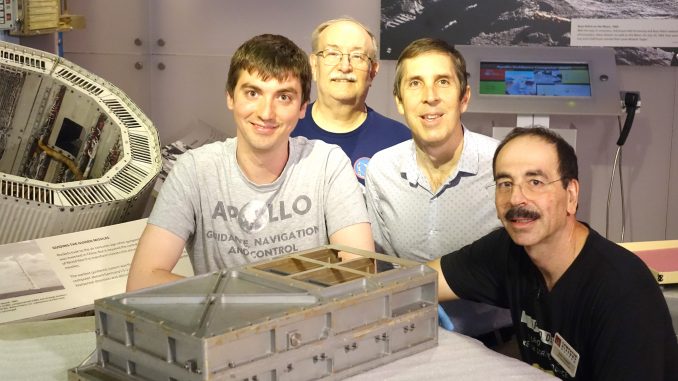Just in time for the 50th anniversary of the moon launch, a group of local computer restoration experts has succeeded in getting a half-century-old Apollo Guidance Computer into working order. They even used it to “land on the moon.”
Source: Daily Post
And tomorrow (July 16), Marc Verdiell of Atherton, Ken Shirriff of Redwood City, Carl Claunch of Los Altos and Mike Stewart of South San Francisco will be in Florida for a very special demo: to show off the newly functional machine to Eldon Hall, the famed scientist who led the MIT team that designed the computers for NASA.
The Apollo Guidance Computer, or AGC, was the computer that navigated Apollo spacecraft to the moon and back, including the landing of the Lunar Modules. Both the Command Module and the Lunar Module each had their own computers. The computer is 70 pounds — “feather-light for the time,” said Verdiell.
You might ask, where does one even get an Apollo computer? Of the 57
so-called Block II designs that were produced, some of course went to
space, but most were used for development and testing. No. 14,
originally used for testing, was found in an electronics scrap warehouse
in Texas by collector and former NASA contractor Jimmie Loocke.
During the years of the Apollo program, Loocke had worked as a
technician testing lunar modules at what is now Johnson Space Center.
Found at an electronics recycler
In a strange coincidence, Loocke was at a Houston electronics recycler in 1976 and thought he saw some hardware he recognized. He bought two tons of scrapped NASA hardware, and after years of sorting through it all, eventually realized he had an actual Lunar Module Apollo Guidance Computer on his hands. And not only did he have the computer, but it looked to be in such good condition that perhaps it could actually be powered up.
This was a dream come true for Stewart, a 28-year-old flight software engineer described by Verdiell and others as a living encyclopedia of the AGC. When Stewart met Loocke in July of last year, he had been working for five years on gathering comprehensive AGC documentation in order to create his own replica.
“I was fairly confident I knew the computer well enough to identify any problems, but as far as trying to figure out how to fix an old computer… I really wanted to get help from people who had done this before and knew what they were doing,” said Stewart.
Verdiell, a 55-year-old Samtec executive, Shirriff, a 51-year-old computer engineer who retired from Google, and Claunch, a 67-year-old retiree, all met a few years ago while volunteering at the Computer History Museum in Mountain View. They had become famous in the small world of vintage computer restoration with a series of blogs and videos they put out documenting their 18-month restoration of a Xerox Alto, the 1973 Xerox PARC machine revered as the mother of all modern personal computers.
Computer was ‘basically flawless’
A mutual acquaintance suggested Stewart meet up with Shirriff, and soon they had a mission: To get the computer working in time for the 50th anniversary of the Apollo 11 mission. Given a chance to get their hands on the Apollo computer, Shirriff, Verdiell and Claunch had only one question: When could they get on the plane to Texas?
In November, the four flew to Houston with testing equipment. They were awed by how well the computer had stood the test of time. “The CPU was basically flawless,” said Verdiell.
The project had its ups and downs, technically and emotionally. In late May, Loocke agreed to bring the computer to California, planning to get the precious machine its own seat next to him on the flight. At the last minute, however, United made him check it. And then he arrived at SFO — and the computer didn’t.
“We all had a heart attack,” Verdiell said. The computer had ended up on a different flight. After four hours, they finally got it back. After that, it was 15 days of working all day, every day on the project in Verdiell’s basement lab.
A switching module had to have its cover carefully chipped away enough to expose the wires below without harming them so they could make a repair.
“It was like an archaeological dig,” said Shirriff.
Finding a tiny fault
One of the pieces that gave them the most trouble was a memory module. Fully encased in a black aluminum sheath, the module was made up of thousands of connectors, tiny metal rings, all threaded together with hair-thin wires in a dense and complicated tapestry. The tapestry is surrounded by silicone rubber, fiberglass and epoxy. Somewhere in there, a piece wasn’t working.
They hoped the fault would be near the surface, where they could get to it more easily. They used a high-resolution X-ray machine at Verdiell’s company, Samtec, but failed to find the fault. Eventually, using Verdiell’s HP radio frequency machines, they discovered the fault was right in the middle of the module.
On the other hand, it turned out one faulty circuit in a different part just needed a good shake from Claunch to get working.
Reverse engineering
Claunch built a replica of the original display and keyboard box, or DSKY, to operate it. Stewart replicated the original MIT/NASA test equipment. Shirriff reverse-engineered the core rope memory module. Verdiell convinced Samtec to help sponsor the project by building and donating about $25,00 worth of replacement connectors so they could hook up the computer to the test equipment. Samtec had to use 1960s documentation to make them.
Claunch estimated that the four men collectively put in about $30,000 of their own money into the project — not counting their time and expertise. The company PCBWay also printed some circuit boards for them, gratis.
“Finally, it works,” said Verdiell. “We load the Apollo 11 software on it. We hook up the interface — Carl’s DSKY. And we run the landing program.”
Computer wanted to know it was in space
And then they ran into a different issue. The computer is not actually in space. It’s been told a rocket has fired, but it hasn’t sensed the acceleration that should result. So the group made an emulator for an accelerometer, to convince the computer that it was actually controlling a Lunar Module and it should calculate the trajectory. After that, on June 16, they really got it to work. They got the computer to descend to the moon and execute a rough landing. “It was kind of a belly flop,” said Stewart.
There were high fives. “When we landed on the moon we all burst into laughter,” said Verdiell. “It was so extraordinary.”
And after they got it working, they just had to know. They simulated the processor overload that had made the Apollo 11 computer famously crash and restart several times during the moon landing. And were amazed by what they saw.
Quick recovery from crashes
“The computer restarts in a fraction of a second,” said Claunch. “And it resumes where it left off.”
“The first time Mike simulated the fault, we missed it,” said Verdiell. The computer’s ability to recover from such a critical condition likely saved the mission, he said.
The men were stunned at the number of technological innovations that had gone into the computer — and by the extraordinary and long-lasting quality of the components: integrated circuits, capacitors and transistors, power supply and more.
As for what’s next? Stewart is still planning to make his replica computer at some point.
“It’ll be hard to top this,” said Claunch.

































Leave a Comment
You must be logged in to post a comment.